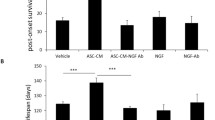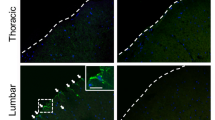Abstract
Amyotrophic lateral sclerosis (ALS) is a devastating human neurodegenerative disease. The precise pathogenic mechanisms of the disease remain uncertain, and as of yet, there is no effective cure. Human adipose stem cells (hASC) can be easily obtained during operative procedures. hASC have a clinically feasible potential to treat neurodegenerative disorders, since cytosolic extract of hASC contain a number of essential neurotrophic factors. In this study, we investigated effects of hASC extract on the SOD1 G93A mouse model of ALS and in vitro test. Administration of hASC extract improved motor function and prolonged the time until symptom onset, rotarod failure, and death in ALS mice. In the hASC extracts group, choline acetyltransferase immunostaining in the ventral horn of the lumbar spinal cord showed a large number of motor neurons, suggesting normal morphology. The neuroprotective effect of hASC extract in ALS mice was also suggested by western blot analysis of spinal cord extract from ALS mice and in vitro test. hASC extract treatment significantly increased expression of p-Akt, p-CREB, and PGC-1α in SOD1 G93A mouse model and in vitro test. Our results indicated that hASC extract reduced apoptotic cell death and recovered mutant SOD1-induced mitochondrial dysfunction. Moreover, hASC extract reduced mitochondrial membrane potential. In conclusion, we have demonstrated, for the first time, that hASC extract exert a potential therapeutic action in the SOD1 G93A mouse model of ALS and in vitro test. These findings suggest that hASC hold promise as a novel therapeutic strategy for treating ALS.





Similar content being viewed by others
Abbreviations
- ALS:
-
Amyotrophic lateral sclerosis
- hASC:
-
Human adipose stem cells
- SOD1:
-
Superoxide dismutase-1
- ChAT:
-
Choline acetyltransferase
- HD:
-
Huntington’s disease
- MMP:
-
Membrane potential
- MSCs:
-
Mesenchymal stem cells
References
Cleveland DW, Rothstein JD (2001) From Charcot to Lou Gehrig: deciphering selective motor neuron death in ALS. Nat Rev Neurosci 2(11):806–819
Rowland LP, Shneider NA (2001) Amyotrophic lateral sclerosis. N Engl J Med 344(22):1688–1700
Boillee S, Vande Velde C, Cleveland DW (2006) ALS: a disease of motor neurons and their nonneuronal neighbors. Neuron 52(1):39–59
Flax JD, Aurora S, Yang C, Simonin C, Wills AM, Billinghurst LL et al (1998) Engraftable human neural stem cells respond to developmental cues, replace neurons, and express foreign genes. Nat Biotechnol 16(11):1033–1039
Goldman S (2005) Stem and progenitor cell-based therapy of the human central nervous system. Nat Biotechnol 23(7):862–871
Kim SU, de Vellis J (2009) Stem cell-based cell therapy in neurological diseases: a review. J Neurosci Res 87(10):2183–2200
Lindvall O, Kokaia Z, Martinez-Serrano A (2004) Stem cell therapy for human neurodegenerative disorders-how to make it work. Nat Med 10(Suppl):S42–S50
Zuk PA, Zhu M, Ashjian P, De Ugarte DA, Huang JI, Mizuno H et al (2002) Human adipose tissue is a source of multipotent stem cells. Mol Biol Cell 13(12):4279–4295
Lin G, Garcia M, Ning H, Banie L, Guo YL, Lue TF et al (2008) Defining stem and progenitor cells within adipose tissue. Stem Cells Dev 17(6):1053–1063
Mizuno H (2010) Adipose-derived stem and stromal cells for cell-based therapy: current status of preclinical studies and clinical trials. Curr Opin Mol Ther 12(4):442–449
Schaffler A, Buchler C (2007) Concise review: adipose tissue-derived stromal cells—basic and clinical implications for novel cell-based therapies. Stem Cells 25(4):818–827
Marconi S, Bonaconsa M, Scambi I, Squintani GM, Rui W, Turano E et al (2013) Systemic treatment with adipose-derived mesenchymal stem cells ameliorates clinical and pathological features in the amyotrophic lateral sclerosis murine model. Neuroscience 248:333–343
Kim KS, Lee HJ, An J, Kim YB, Ra JC, Lim I et al (2014) Transplantation of human adipose tissue-derived stem cells delays clinical onset and prolongs life span in ALS mouse model. Cell Transplant 23(12):1585–1597
Nakagami H, Maeda K, Morishita R, Iguchi S, Nishikawa T, Takami Y et al (2005) Novel autologous cell therapy in ischemic limb disease through growth factor secretion by cultured adipose tissue-derived stromal cells. Arterioscler Thromb Vasc Biol 25(12):2542–2547
Lee JW, Fang X, Krasnodembskaya A, Howard JP, Matthay MA (2011) Concise review: mesenchymal stem cells for acute lung injury: role of paracrine soluble factors. Stem Cells 29(6):913–919
Li F, Whyte N, Niyibizi C (2012) Differentiating multipotent mesenchymal stromal cells generate factors that exert paracrine activities on exogenous MSCs: implications for paracrine activities in bone regeneration. Biochem Biophys Res Commun 426(4):475–479
Gnecchi M, Zhang Z, Ni A, Dzau VJ (2008) Paracrine mechanisms in adult stem cell signaling and therapy. Circ Res 103(11):1204–1219
Martino G, Pluchino S (2006) The therapeutic potential of neural stem cells. Nat Rev Neurosci 7(5):395–406
Rehman J, Traktuev D, Li J, Merfeld-Clauss S, Temm-Grove CJ, Bovenkerk JE et al (2004) Secretion of angiogenic and antiapoptotic factors by human adipose stromal cells. Circulation 109(10):1292–1298
Lee ST, Chu K, Jung KH, Im WS, Park JE, Lim HC et al (2009) Slowed progression in models of Huntington disease by adipose stem cell transplantation. Ann Neurol 66(5):671–681
Heo SC, Jeon ES, Lee IH, Kim HS, Kim MB, Kim JH (2011) Tumor necrosis factor-alpha-activated human adipose tissue-derived mesenchymal stem cells accelerate cutaneous wound healing through paracrine mechanisms. J Invest Dermatol 31(7):1559–1567
Im W, Ban J, Lim J, Lee M, Lee ST, Chu K et al (2013) Extracts of adipose derived stem cells slows progression in the R6/2 model of Huntington’s disease. PLoS One 8(4):e59438
Liu T, Im W, Lee ST, Ban JJ, Chai YJ, Lee M et al (2014) Modulation of mitochondrial function by stem cell-derived cellular components. Biochem Biophys Res Commun 448(4):403–408
Cozzolino M, Rossi S, Mirra A, Carri MT (2015) Mitochondrial dynamism and the pathogenesis of amyotrophic lateral sclerosis. Front Cell Neurosci 9:31
Palomo GM, Manfredi G (2015) Exploring new pathways of neurodegeneration in ALS: the role of mitochondria quality control. Brain Res 1607:36–46
Vehvilainen P, Koistinaho J, Gundars G (2014) Mechanisms of mutant SOD1 induced mitochondrial toxicity in amyotrophic lateral sclerosis. Front Cell Neurosci 8:126
Joo IS, Hwang DH, Seok JI, Shin SK, Kim SU (2007) Oral administration of memantine prolongs survival in a transgenic mouse model of amyotrophic lateral sclerosis. J Clin Neurol 3(4):181–186
Crawley JN (2008) Behavioral phenotyping strategies for mutant mice. Neuron 57(6):809–818
Hetz C, Thielen P, Fisher J, Pasinelli P, Brown RH, Korsmeyer S et al (2007) The proapoptotic BCL-2 family member BIM mediates motoneuron loss in a model of amyotrophic lateral sclerosis. Cell Death Differ 14(7):1386–1389
Koh SH, Kim Y, Kim HY, Hwang S, Lee CH, Kim SH (2007) Inhibition of glycogen synthase kinase-3 suppresses the onset of symptoms and disease progression of G93A-SOD1 mouse model of ALS. Exp Neurol 205(2):336–346
Ahn SW, Kim JE, Park KS, Choi WJ, Hong YH, Kim SM et al (2012) The neuroprotective effect of the GSK-3beta inhibitor and influence on the extrinsic apoptosis in the ALS transgenic mice. J Neurol Sci 320(1–2):1–5
Azari H, Rahman M, Sharififar S, Reynolds BA (2010) Isolation and expansion of the adult mouse neural stem cells using the neurosphere assay. J Vis Exp. doi:10.3791/2393
Kim SM, Kim H, Lee JS, Park KS, Jeon GS, Shon J et al (2013) Intermittent hypoxia can aggravate motor neuronal loss and cognitive dysfunction in ALS mice. PLoS One 8(11):e81808
Ahn SW, Jeon GS, Kim MJ, Shon JH, Kim JE, Shin JY et al (2014) Neuroprotective effects of JGK-263 in transgenic SOD1-G93A mice of amyotrophic lateral sclerosis. J Neurol Sci 340(1–2):112–116
Da Cruz S, Parone PA, Lopes VS, Lillo C, McAlonis-Downes M, Lee SK et al (2012) Elevated PGC-1alpha activity sustains mitochondrial biogenesis and muscle function without extending survival in a mouse model of inherited ALS. Cell Metab 15(5):778–786
Liang F, Chen R, Nakagawa A, Nishizawa M, Tsuda S, Wang H et al (2011) Low-Frequency Electroacupuncture Improves Insulin Sensitivity in Obese Diabetic Mice through Activation of SIRT1/PGC-1alpha in Skeletal Muscle. Evid Based Complement Alternat Med 735297
Zhao W, Varghese M, Yemul S, Pan Y, Cheng A, Marano P et al (2011) Peroxisome proliferator activator receptor gamma coactivator-1alpha (PGC-1alpha) improves motor performance and survival in a mouse model of amyotrophic lateral sclerosis. Mol Neurodegener 6(1):51
Green DR, Reed JC (1998) Mitochondria and apoptosis. Science 281(5381):1309–1312
Pasinelli P, Brown RH (2006) Molecular biology of amyotrophic lateral sclerosis: insights from genetics. Nat Rev Neurosci 7(9):710–723
Shi P, Gal J, Kwinter DM, Liu X, Zhu H (2010) Mitochondrial dysfunction in amyotrophic lateral sclerosis. Biochim Biophys Acta 1802(1):45–51
Ferraiuolo L, Kirby J, Grierson AJ, Sendtner M, Shaw PJ (2011) Molecular pathways of motor neuron injury in amyotrophic lateral sclerosis. Nat Rev Neurol 7(11):616–630
Wiedemann FR, Winkler K, Kuznetsov AV, Bartels C, Vielhaber S, Feistner H et al (1998) Impairment of mitochondrial function in skeletal muscle of patients with amyotrophic lateral sclerosis. J Neurol Sci 156(1):65–72
Fuchs A, Kutterer S, Muhling T, Duda J, Schutz B, Liss B et al (2013) Selective mitochondrial Ca2+ uptake deficit in disease endstage vulnerable motoneurons of the SOD1G93A mouse model of amyotrophic lateral sclerosis. J Physiol 591(Pt 10):2723–2745
Jung C, Higgins CM, Xu Z (2002) Mitochondrial electron transport chain complex dysfunction in a transgenic mouse model for amyotrophic lateral sclerosis. J Neurochem 83(3):535–545
Kong J, Xu Z (1998) Massive mitochondrial degeneration in motor neurons triggers the onset of amyotrophic lateral sclerosis in mice expressing a mutant SOD1. J Neurosci 18(9):3241–3250
Guegan C, Przedborski S (2003) Programmed cell death in amyotrophic lateral sclerosis. J Clin Investig 111(2):153–161
Pasinelli P, Belford ME, Lennon N, Bacskai BJ, Hyman BT, Trotti D et al (2004) Amyotrophic lateral sclerosis-associated SOD1 mutant proteins bind and aggregate with Bcl-2 in spinal cord mitochondria. Neuron 43(1):19–30
Hwang DH, Lee HJ, Park IH, Seok JI, Kim BG, Joo IS et al (2009) Intrathecal transplantation of human neural stem cells overexpressing VEGF provide behavioral improvement, disease onset delay and survival extension in transgenic ALS mice. Gene Ther 16(10):1234–1244
Kaspar BK, Llado J, Sherkat N, Rothstein JD, Gage FH (2003) Retrograde viral delivery of IGF-1 prolongs survival in a mouse ALS model. Science 301(5634):839–842
Acknowledgments
This study was supported by Grants from the Korea Healthcare Technology R&D project, Ministry of health and Welfare, Republic of Korea (HI14C3347).
Author information
Authors and Affiliations
Corresponding authors
Additional information
Gye Sun Jeon and Wooseok Im have contributed equally to this work.
Electronic supplementary material
Below is the link to the electronic supplementary material.
Figure S1
Comparison of growth factors between hASC and hASC extract. BDNF, VEGF, PDGF-1, IGF-1, HGF-α, FGF-2 were investigated in hASC or hASC extract by western blot. The results showed that both groups contained various growth factors similarly (BDNF, Brain-derived neurotrophic factor; VEGF, Vascular endothelial growth factor; PDGF-1, Platelet-derived growth factor-1; IGF-1, Insulin-like growth factors-1; HGF-α, Hepatocyte growth factor-α; FGF-2, Fibroblast growth factor-2) (JPEG 273 kb)
Rights and permissions
About this article
Cite this article
Jeon, G.S., Im, W., Shim, YM. et al. Neuroprotective Effect of Human Adipose Stem Cell-Derived Extract in Amyotrophic Lateral Sclerosis. Neurochem Res 41, 913–923 (2016). https://doi.org/10.1007/s11064-015-1774-z
Received:
Revised:
Accepted:
Published:
Issue Date:
DOI: https://doi.org/10.1007/s11064-015-1774-z




